Printing the Ultra-Long Ag Nanowires Inks onto the Flexible Textile Substrate for Stretchable Electronics
Abstract
:1. Introduction
2. Methods
2.1. Materials and Chemicals
2.2. Formulation of Ag NWs Inks
2.3. Characterization
3. Results and Discussion
4. Conclusions
Author Contributions
Funding
Conflicts of Interest
Abbreviations
References
- Wu, W. Stretchable electronics: Functional materials, fabrication strategies and applications. Sci. Technol. Adv. Mater. 2019, 20, 187–224. [Google Scholar] [CrossRef]
- Rogers, J.A.; Someya, T.; Huang, Y. Materials and Mechanics for Stretchable Electronics. Science 2010, 327, 1603–1607. [Google Scholar] [CrossRef] [PubMed]
- Atalay, A.; Sanchez, V.; Atalay, O.; Vogt, D.M.; Haufe, F.; Wood, R.J.; Walsh, C.J. Batch fabrication of customizable silicone-textile composite capacitive strain sensors for human motion tracking. Adv. Mater. Technol. 2017, 2, 1700136. [Google Scholar] [CrossRef]
- Cui, H.W.; Suganuma, K.; Uchida, H. Highly stretchable, electrically conductive textiles fabricated from silver nanowires and cupro fabrics using a simple dipping-drying method. Nano Res. 2015, 8, 1604–1614. [Google Scholar] [CrossRef]
- Seo, J.W.; Joo, M.; Ahn, J.; Lee, T.I.; Kim, T.S.; Im, S.G.; Lee, J.Y. Facilitated embedding of silver nanowires into conformally-coated iCVD polymer films deposited on cloth for robust wearable electronics. Nanoscale 2017, 9, 3399–3407. [Google Scholar] [CrossRef] [PubMed]
- Hsu, P.C.; Liu, X.; Liu, C.; Xie, X.; Lee, H.R.; Welch, A.J.; Cui, Y. Personal thermal management by metallic nanowire-coated textile. Nano Lett. 2014, 15, 365–371. [Google Scholar] [CrossRef]
- Liu, L.; Lu, Q.; Yang, S.; Guo, J.; Tian, Q.; Yao, W.; Wu, W. All-Printed Solid-State Microsupercapacitors Derived from Self-Template Synthesis of Ag@PPy Nanocomposites. Adv. Mater. Technol. 2018, 3, 1700206. [Google Scholar] [CrossRef]
- Lian, L.; Dong, D.; Yang, S.; Wei, B.; He, G. Highly Conductive and Uniform Alginate/Silver Nanowire Composite Transparent Electrode by Room Temperature Solution Processing for Organic Light Emitting Diode. ACS Appl. Mater. Interfaces 2017, 9, 11811–11818. [Google Scholar] [CrossRef]
- Cui, S.Y.; Liu, J.; Wu, W. Preparation of Metal Nanoparticles-Based Conductive Inks and Their Applications in Printed Electronics. Prog. Chem. 2015, 27, 1509–1522. [Google Scholar]
- Liu, L.; Feng, Y.; Wu, W. Recent progress in printed flexible solid-state supercapacitors for portable and wearable energy storage. J. Power Sources 2019, 410, 69–77. [Google Scholar] [CrossRef]
- Chen, S.; Guan, Y.; Li, Y.; Yan, X.; Ni, H.; Li, L. A water-based silver nanowire ink for large-scale flexible transparent conductive films and touch screens. J. Mater. Chem. C 2017, 5, 2404–2414. [Google Scholar] [CrossRef]
- Wu, W. Inorganic nanomaterials for printed electronics: A review. Nanoscale 2017, 9, 7342–7372. [Google Scholar] [CrossRef]
- Jeong, S.; Lee, S.H.; Jo, Y.; Lee, S.S.; Seo, Y.H.; Ahn, B.W.; Choi, Y. Air-stable, surface-oxide free Cu nanoparticles for highly conductive Cu ink and their application to printed graphene transistors. J. Mater. Chem. C 2013, 1, 2704–2710. [Google Scholar] [CrossRef]
- Kosmala, A.; Wright, R.; Zhang, Q.; Kirby, P. Synthesis of silver nano particles and fabrication of aqueous Ag inks for inkjet printing. Mater. Chem. Phys. 2011, 129, 1075–1080. [Google Scholar] [CrossRef]
- Matsuhisa, N.; Kaltenbrunner, M.; Yokota, T.; Jinno, H.; Kuribara, K.; Sekitani, T.; Someya, T. Printable elastic conductors with a high conductivity for electronic textile applications. Nat. Commun. 2015, 6, 7461. [Google Scholar] [CrossRef] [PubMed]
- Liu, L.; Wan, X.; Sun, L.; Yang, S.; Dai, Z.; Tian, Q.; Wu, W. Anion-mediated synthesis of monodisperse silver nanoparticles useful for screen printing of high-conductivity patterns on flexible substrates for printed electronics. Rsc. Adv. 2015, 5, 9783–9791. [Google Scholar] [CrossRef]
- Hemmati, S.; Barkey, D.P.; Gupta, N. Rheological behavior of silver nanowire conductive inks during screen printing. J. Nanopar. Res. 2016, 18, 249. [Google Scholar] [CrossRef]
- Liang, J.; Tong, K.; Pei, Q.A. Water-Based Silver-Nanowire Screen-Print Ink for the Fabrication of Stretchable Conductors and Wearable Thin-Film Transistors. Adv. Mater. 2016, 28, 5986–5996. [Google Scholar] [CrossRef]
- Xue, Q.; Yao, W.; Liu, J.; Tian, Q.; Liu, L.; Li, M.; Wu, W. Facile Synthesis of Silver Nanowires with Different Aspect Ratios and Used as High-Performance Flexible Transparent Electrodes. Nanoscale Res. Lett. 2017, 12, 480. [Google Scholar] [CrossRef]
- Faddoul, R.; Reverdy-Bruas, N.; Blayo, A. Formulation and screen printing of water based conductive flake silver pastes onto green ceramic tapes for electronic applications. Mater. Sci. Eng. B 2012, 177, 1053–1066. [Google Scholar] [CrossRef]
- Liang, J.; Jiang, C.Z.; Wu, W. Towards fiber-, paper- and foam-like flexible solid-state supercapacitors: Electrode materials and device design. Nanoscale 2019, 11, 7041–7061. [Google Scholar] [CrossRef]
- Zeng, P.; Tian, Q.; Yao, W.; Li, M.; Tian, B.; Wang, H.; Feng, Y.; Liu, L.; Wu, W. Screen-printed, low-cost and patterned flexible heater based on Ag fractal dendrites for human wearable application. Adv. Mater. Technol. 2019, 4, 1800453. [Google Scholar] [CrossRef]
- Tian, B.; Yao, W.; Zeng, P.; Li, X.; Wang, H.; Liu, L.; Wu, W. All-printed, low-cost, tunable sensing range strain sensors based on Ag nanodendrite conductive inks for wearable electronics. J. Mater. Chem. C 2019, 7, 809–818. [Google Scholar] [CrossRef]
- Amalu, E.H.; Ekere, N.N.; Mallik, S. Evaluation of rheological properties of lead-free solder pastes and their relationship with transfer efficiency during stencil printing process. Mater. Des. 2011, 32, 3189–3197. [Google Scholar] [CrossRef]
- Durairaj, R.; Ramesh, S.; Mallik, S.; Seman, A.; Ekere, N. Rheological characterisation and printing performance of Sn/Ag/Cu solder pastes. Mater. Des. 2009, 30, 3812–3818. [Google Scholar] [CrossRef]
- Songping, W. Preparation of micron size flake silver powders for conductive thick films. J. Mater. Sci. Mater. Electron. 2007, 18, 447–452. [Google Scholar] [CrossRef]
- Yin, W.; Lee, D.H.; Choi, J.; Park, C.; Cho, S.M. Screen printing of silver nanoparticle suspension for metal interconnects. Korean J. Chem. Eng. 2008, 25, 1358–1361. [Google Scholar] [CrossRef]
- Park, K.; Seo, D.; Lee, J. Conductivity of silver paste prepared from nanoparticles. Coll. Surf. A Physicochem. Eng. Asp. 2008, 313, 351–354. [Google Scholar] [CrossRef]
- Merilampi, S.; Laine-Ma, T.; Ruuskanen, P. The characterization of electrically conductive silver ink patterns on flexible substrates. Microelectron. Reliab. 2009, 49, 782–790. [Google Scholar] [CrossRef]
- Jin, H.; Matsuhisa, N.; Lee, S.; Abbas, M.; Yokota, T.; Someya, T. Enhancing the Performance of Stretchable Conductors for E-Textiles by Controlled Ink Permeation. Adv. Mater. 2017, 29, 1605848. [Google Scholar] [CrossRef]
- Faddoul, R.; Reverdy-Bruas, N.; Bourel, J. Silver content effect on rheological and electrical properties of silver pastes. J. Mater. Sci. Mater. Electron. 2012, 23, 1415–1426. [Google Scholar] [CrossRef]
- Zhou, Y.; Cao, S.; Wang, J.; Zhu, H.; Wang, J.; Yang, S.; Kong, D. Bright Stretchable Electroluminescent Devices based on Silver Nanowire Electrodes and High-k Thermoplastic Elastomers. ACS Appl. Mater. Interfaces 2018, 10, 44760–44767. [Google Scholar] [CrossRef]
- Jiu, J.; Araki, T.; Wang, J.; Nogi, M.; Sugahara, T.; Nagao, S.; Uchida, H. Facile synthesis of very-long silver nanowires for transparent electrodes. J. Mater. Chem. A 2014, 2, 6326–6330. [Google Scholar] [CrossRef]
- Liu, X.; Li, D.; Chen, X.; Lai, W.Y.; Huang, W. Highly Transparent and Flexible All-Solid-State Supercapacitors Based on Ultralong Silver Nanowire Conductive Networks. ACS Appl. Mater. Interfaces 2018, 10, 32536–32542. [Google Scholar] [CrossRef]
- Chen, S.; Li, Y.; Jin, R.; Guan, Y.; Ni, H.; Wan, Q.; Li, L. A systematic and effective research procedure for silver nanowire ink. J. Alloy. Compd. 2017, 706, 164–175. [Google Scholar] [CrossRef]
- Hollies, N.R.; Kaessinger, M.M.; Watson, B.S.; Bogaty, H. Water Transport Mechanisms in Textile Materials: Part II: Capillary-Type Penetration in Yarns and Fabrics. Text. Res. J. 1957, 27, 8–13. [Google Scholar] [CrossRef]
- Wang, Q.; Su, B.; Liu, H.; Jiang, L. Chinese Brushes: Controllable Liquid Transfer in Ratchet Conical Hairs. Adv. Mater. 2014, 26, 4889–4894. [Google Scholar] [CrossRef] [PubMed]
- Yuan, J.; Liu, X.; Akbulut, O.; Hu, J.; Suib, S.L.; Kong, J.; Stellacci, F. Superwetting nanowire membranes for selective absorption. Nat. Nanotechnol. 2008, 3, 332–336. [Google Scholar] [CrossRef]
- Liu, X.; Lu, C.; Wu, X.; Zhang, X. Self-healing strain sensors based on nanostructured supramolecular conductive elastomers. J. Mater. Chem. A 2017, 5, 9824–9832. [Google Scholar] [CrossRef]
- Wang, S.; Zhang, X.; Wu, X.; Lu, C. Tailoring percolating conductive networks of natural rubber composites for flexible strain sensors via a cellulose nanocrystal templated assembly. Soft Matter 2016, 12, 845–852. [Google Scholar] [CrossRef] [PubMed]
- Hu, Y.; Zhao, T.; Zhu, P.; Zhu, Y.; Shuai, X.; Liang, X.; Wong, C.P. Low cost and highly conductive elastic composites for flexible and printable electronics. J. Mater. Chem. C 2016, 4, 5839–5848. [Google Scholar] [CrossRef]
- Zhang, S.; Li, Y.; Tian, Q.; Liu, L.; Yao, W.; Chi, C.; Wu, W. Highly conductive, flexible and stretchable conductors based on fractal silver nanostructures. J. Mater. Chem. C 2018, 6, 3999–4006. [Google Scholar] [CrossRef]
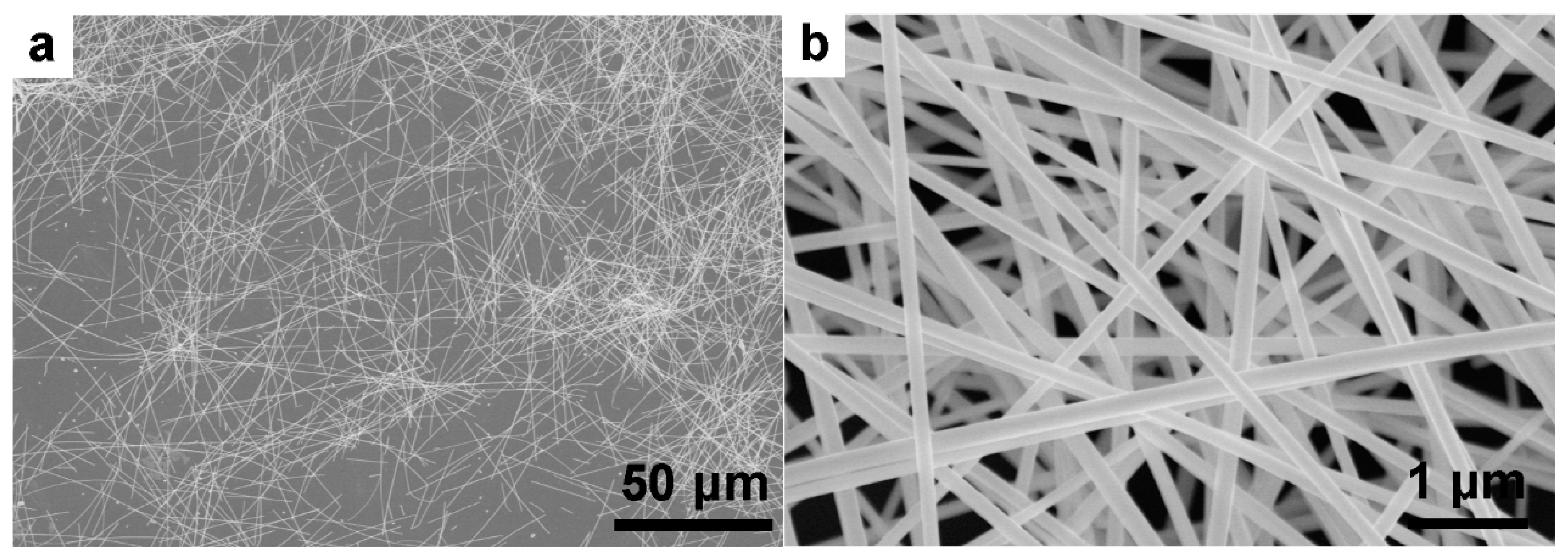
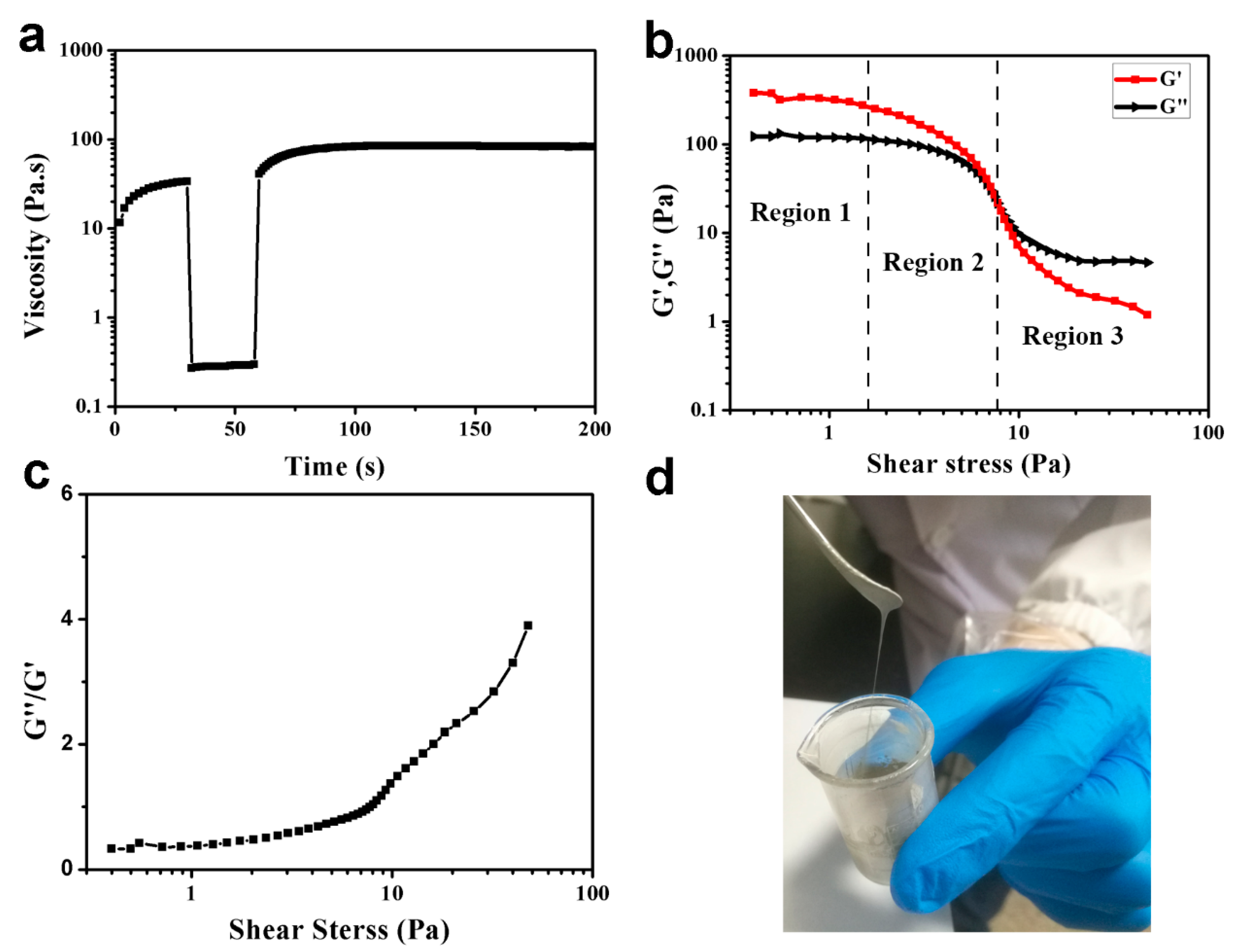
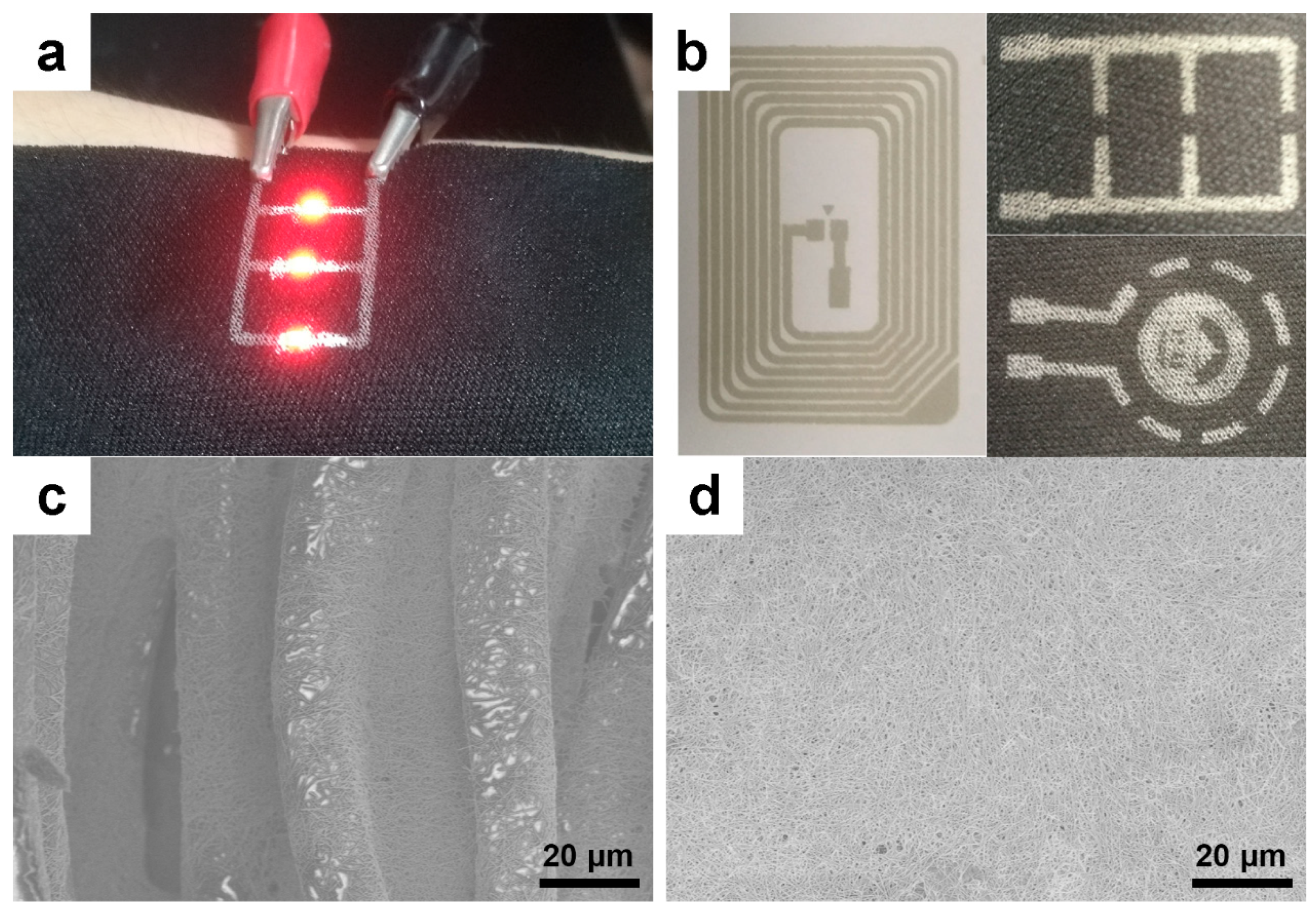
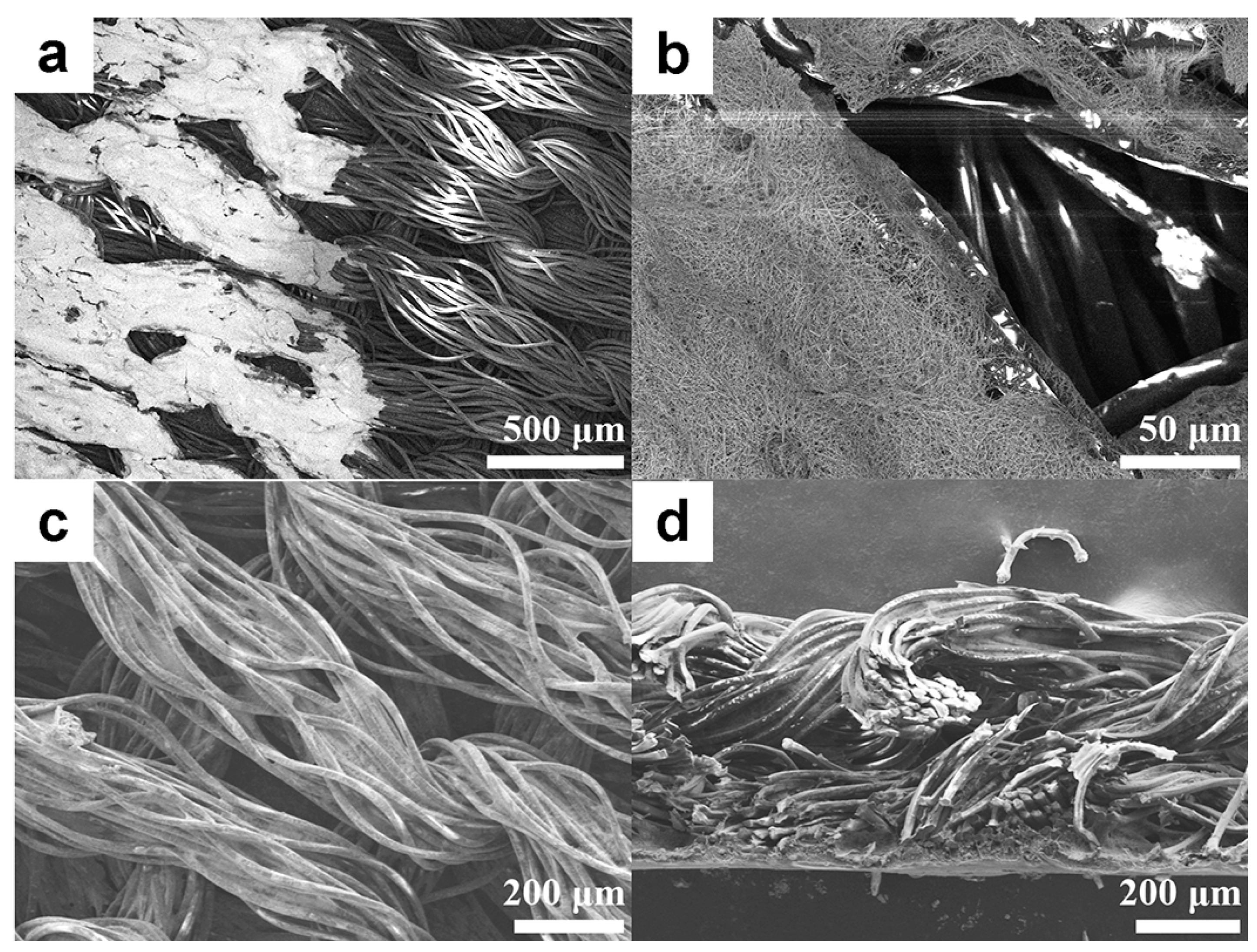
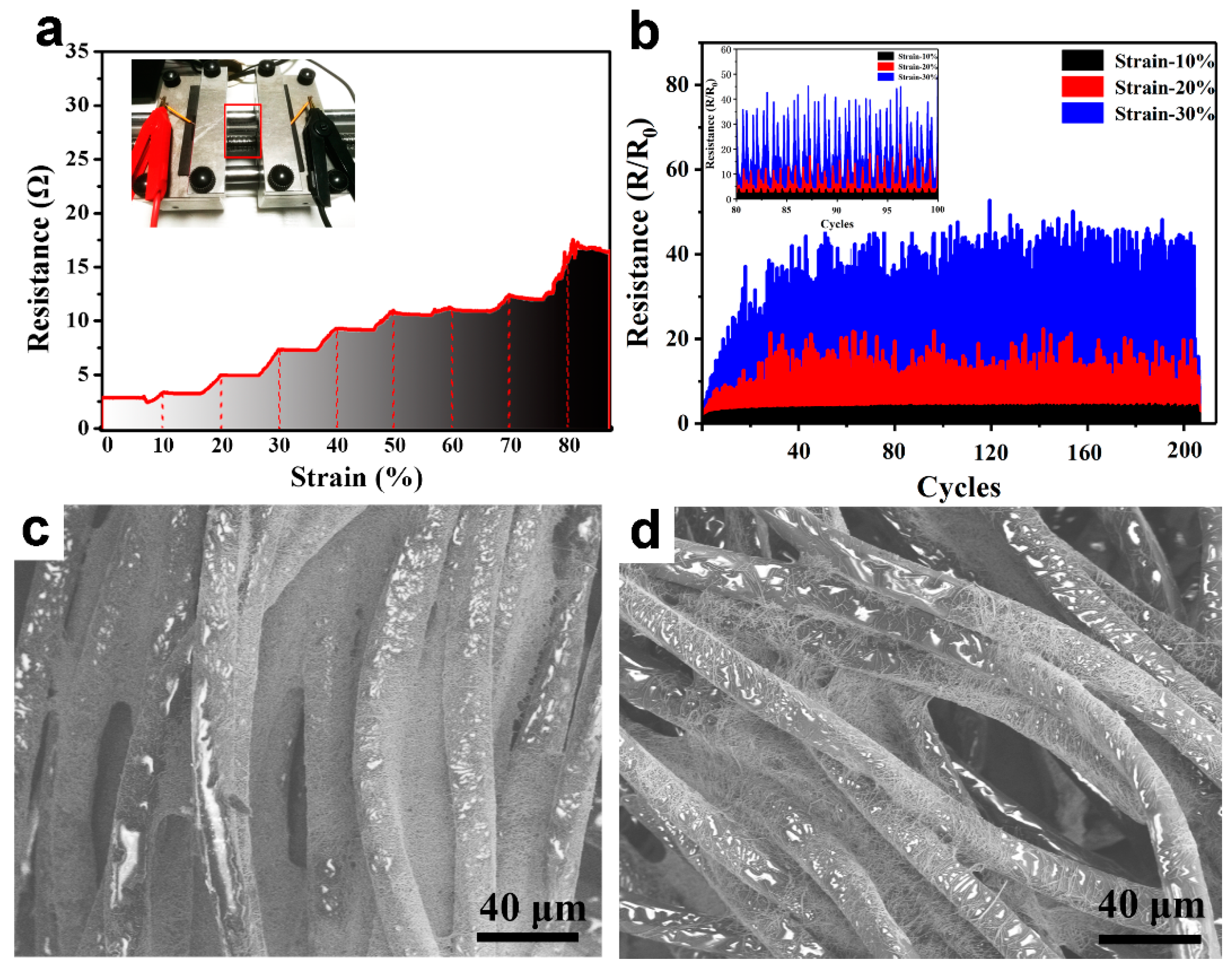
| Conductive Contents (wt %) | Sintering Temperature | Printed Substrate | Sheet Resistance | Ref. |
|---|---|---|---|---|
| Ag flakes (70%) | 850 °C | ferrite | 0.022 Ω/sq | [26] |
| Ag NPs (60%) | 200 °C | Glass | 0.156 Ω/sq | [27] |
| Ag NPs (80%) | 450 °C | alumina | 0.006 Ω/sq | [28] |
| Ag flakes (70%) | 120–180 °C | PET/Paper/PI | 0.13 Ω/sq | [29] |
| Ag flakes (70%) | 875 °C | LTCC | 0.004 Ω/sq | [20] |
| Ag flakes (75%) | 160 °C | textile | 0.06 Ω/sq | [30] |
| Ag flakes (70%) | 700 °C | alumina | 0.009 Ω/sq | [31] |
| Ag NWs | 160 °C | TPU | 2.1 Ω/sq | [32] |
| Ag NWs | Room temperature | Glass | 9.2 Ω/sq | [33] |
| Ag NWs (0.36%) | 120 °C | PET | 15.2 Ω/sq | [34] |
| Ag NWs (0.4%) | 110 °C | PET | 29.5 Ω/sq | [35] |
| Ag NWs (3.7%) | 25 °C | Textile/paper | 1.5/0.7 Ω/sq | Present work |
© 2019 by the authors. Licensee MDPI, Basel, Switzerland. This article is an open access article distributed under the terms and conditions of the Creative Commons Attribution (CC BY) license (http://creativecommons.org/licenses/by/4.0/).
Share and Cite
Ke, S.-H.; Xue, Q.-W.; Pang, C.-Y.; Guo, P.-W.; Yao, W.-J.; Zhu, H.-P.; Wu, W. Printing the Ultra-Long Ag Nanowires Inks onto the Flexible Textile Substrate for Stretchable Electronics. Nanomaterials 2019, 9, 686. https://doi.org/10.3390/nano9050686
Ke S-H, Xue Q-W, Pang C-Y, Guo P-W, Yao W-J, Zhu H-P, Wu W. Printing the Ultra-Long Ag Nanowires Inks onto the Flexible Textile Substrate for Stretchable Electronics. Nanomaterials. 2019; 9(5):686. https://doi.org/10.3390/nano9050686
Chicago/Turabian StyleKe, Sheng-Hai, Qing-Wen Xue, Chuan-Yuan Pang, Pan-Wang Guo, Wei-Jing Yao, He-Ping Zhu, and Wei Wu. 2019. "Printing the Ultra-Long Ag Nanowires Inks onto the Flexible Textile Substrate for Stretchable Electronics" Nanomaterials 9, no. 5: 686. https://doi.org/10.3390/nano9050686





